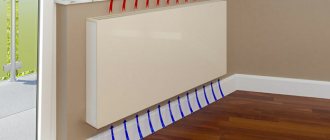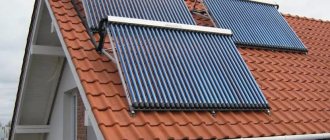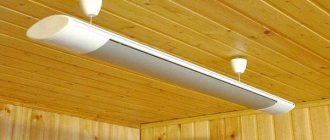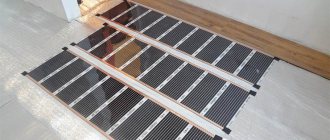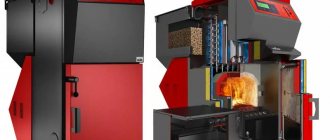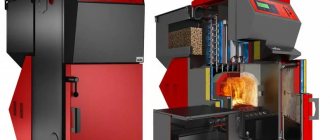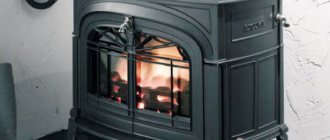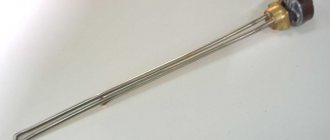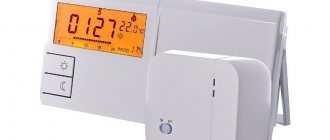Heating systems for non-residential and residential premises are presented on the market in huge quantities. And among all this variety, the film infrared heater stands out for its high efficiency, long service life and increased operational safety.
The article we presented describes in detail the operating principle of the equipment used to form radiant heating. Advantages and disadvantages are listed, technical characteristics are given. We will introduce applications and methods of constructing popular film systems.
Options for using technology
Infrared heating is used quite widely today.
Regardless of whether a person lives in the house permanently or uses the home as a temporary shelter, such devices are ideal for heating living rooms at any time of the year. But this is not the only area of their application. Such units can be used for heating balconies and loggias, unheated garages, dressing rooms, terraces, verandas of open and closed gazebos, greenhouses and winter gardens, chicken coops and other premises for animals.
With the help of such devices, you can very quickly reach the desired room temperature, warm the soil, extend the summer season, reap a good harvest, and achieve amazing results in livestock farming. At the same time, creating a comfortable microclimate will not provoke an increase in electricity costs, which leads to significant financial savings.
Features of the film heater
Infrared film wall heaters are quite popular. They consist of a resistive-type heating element, a heat-distributing base, a thermostat, two protective layers and a connection cable. The total thickness of the sheet is no more than 1.5 mm.
The thermostat has a temperature sensor, which simplifies operation. The laminating film used in this work can withstand temperatures up to 210˚C. Such layers are used as protective layers; between them there is foil with heating elements. This infrared flexible film wall heater has resistors, and the heating elements are based on metals or carbon-containing materials. When an electric current passes through them, heating occurs up to a maximum of 55 ˚C.
Operating principle of a film electric heater
When electric current passes through the heating element, heat is generated on it. It spreads by contact method along the transmission element (aluminum foil) to the surface of the heater (PET film). When heated, the surface of the heater begins to emit infrared waves in the mid-wave range: 8.6–9.2 microns.
Ranges of infrared radiation and corresponding temperatures in °C:
- near region: λ = 0.74–2.5 µm (from +3,650 to +877 °C);
- medium region: λ = 2.5–50 μm (from +877 to -215 °C);
- distant region: λ = 50–2000 µm (from -215 to -257 °C).
The dependence of the wavelength on the temperature of the heated body is calculated according to Wien's displacement law.
Main types of infrared heaters
Infrared heaters for the home are presented on the product market in a variety of types and characteristics.
Classification of devices
Heaters are distinguished by the following features:
- By type of placement. Ceiling, wall, floor and film are available. The first two types of placement involve stationary use. They are mounted using brackets or hooks, respectively, on the ceiling or wall. Since the design is lightweight, there are no special requirements for fasteners. Floor-standing devices have a special stand in their design, on which they are installed anywhere on the floor. A special type is film devices. The heating element here is a flexible resist cable that heats the outer metal film.
- By radiation power. Infrared heaters for home are manufactured with a power from 200 W to 2.5 kW, and those intended for use in industrial areas - over 2 kW.
- According to the range of waves used. Waves lying in the range from 5.6 to 100 microns are called long-wavelength. They have an operating temperature of about 600 degrees and are completely harmless to the human body. The range from 2.5 to 5.6 microns is called mid-wave, the heating temperature can be 1 thousand degrees. Such devices are used in rooms with high ceilings. Short-wave, using a wavelength of up to 2.5 microns, are considered harmful to the human body, and are used for ceiling mounting at a height of 5-7 meters.
- Based on the type of heating element used, heaters are structurally divided into lamp, panel, and film. Lamp ones are made with a tubular heating element. They differ in shape, flask filling (vacuum or gas), and spiral material. Typically, in addition to the lamp, the device includes a reflector and a protective transparent screen. Panel heaters are produced in the form of flat panels of various sizes. The heater itself is made of quartz or carbonite.
- Depending on the method of powering, devices can be electric, gas or diesel.
Halogen lamps are low cost, but when they work, heating light is visible. While quartz and carbon, although more expensive, work in the invisible spectrum for the human eye.
Micathermic heater
This device is a new technological solution on the IR heaters market. The radiation source in the device is the plate. This plate is made of several layers of mica, due to which thermal radiation spreads evenly and heating occurs very quickly. It must contain protection against overheating and overturning of the device.
The main advantages are efficiency, since energy costs are lower by almost 30 percent compared to other types of IR heaters. The case temperature does not exceed 50 degrees, complete silence. Different body variations make this product even more attractive. Greater degree of mobility. The main manufacturer is Polaris. The disadvantage of such a heater is its price.
Advantages and disadvantages
The main advantage of such equipment is high efficiency. A person, like an object, heats up under the influence of infrared radiation. Almost immediately after turning on the device in the room, a person begins to feel warmth.
In addition, among the advantages of IR heaters are:
- High efficiency. The effectiveness of such heating lies in the direct thermal effect on the object without loss of power for heating the air environment.
- Cost-effectiveness, which is ensured by a long period of heat transfer from heated objects and the absence of dependence on air flows (drafts).
- Versatility. IR emitters can be used both indoors and outdoors. The owner can independently adjust the power and radiation angle.
- Easy to install and operate.
In addition, IR heaters do not dry out the air, which is very important for maintaining a healthy indoor microclimate. Despite the abundance of advantages, IR heaters also have disadvantages, namely:
- As soon as a person leaves the radiation zone, he immediately begins to feel a temperature difference.
- Dimensions that directly depend on the power of the device.
- Fire hazard if the emitter is not focused correctly.
The issue of the safety of long-term human exposure to infrared radiation is being actively discussed online. Doctors and physicists have not been able to reach consensus on this issue, so the lack of confidence in the safety of these devices for humans should also be considered a disadvantage.
Some notes and recommendations for use
- One should not expect high efficiency from film IR heaters, as well as from any other heating units, in the absence of thermal insulation of the housing enclosing structures.
- Marketers' statements about the PLEN wavelength of 8 microns, supposedly optimal for human perception, do not correspond to reality - the radiation of IR heaters is always in a certain range and cannot consist of waves of any one length.
- Installing PLEN in one room, even over the entire area of the enclosing structures, will not solve the problem of heating other rooms for the house.
- The operation of PLEN is not accompanied by a decrease in oxygen in the room air, so there is no need to increase the frequency of room ventilation when using film heaters.
- It is not necessary to turn off the PLEN system in the summer - just set the thermostat to the desired temperature value.
- The durability of infrared film heaters declared by manufacturers (up to 50 years) is a hypothetical value, since PLENs began to be produced relatively recently.
- The safety requirements for household electrical appliances, including film-type ones, are set out in GOST R 52161.2.96-2006.
Installation of film-type IR heaters
Installation of flexible film heaters, regardless of the installation location, does not require the contractor to have high-level professional skills, but must be carried out in compliance with the following rules:
- the installation site of the PLEN must be level and dry;
- cutting rolls, if provided for by the model, should be performed only according to the markings specified by the manufacturer;
- testing the functionality by plugging in a rolled-up heater is prohibited;
- the length of one strip film fragment should not exceed 8 m;
- adjacent strips of the heating system are located at a distance of at least 5 mm;
- bending the PLEN at an angle of more than 90 degrees is not allowed;
- installation of the film to the base is carried out with staples using a construction stapler or special fasteners (the use of ordinary nails and self-tapping screws is not effective);
- It is prohibited to carry out installation work at sub-zero air temperatures - after warming up the room, the film strips will increase in size and form folds.
Sequence of installation of film IR heaters
To protect against overheating, the base for placing the PLEN must be equipped with a foil reflective screen that acts as a heat and water insulator, for example, penofol, isolon.
The protective coating is mounted on the base with an overlap of adjacent edges of 3-5 cm; to speed up the process, it is advisable to use special fasteners for fastening, which are available in a wide range on sale.
From above, the joints of the screen strips are glued longitudinally with special foil tape.
The elements of the film heater are mounted on top of the laid screen - after preliminary layout and in accordance with the installation instructions supplied with the device. Installation is carried out taking into account the rule - for 1 square meter of flexible film there should be 8-10 fastening elements.
When the heating circuit is ready to be installed, it is connected to the thermostat, which should be located at a height of 1-1.5 m from the floor, and the system’s functionality is checked.
In addition, to correctly monitor the temperature in the room, the thermostat must be located away from other heating devices, have a thermal insulation pad underneath, and be protected from direct sunlight and drafts.
If the results of testing the IR device are positive, finishing materials are laid - floor covering or suspended ceiling, which are installed with a gap of 10-15 mm between the cladding and the film.
Read on the topic - how to attach, lay and glue penofol.
Caleo GOLD 230-0.5 230 W
Thin infrared film rolled into a roll. Mat length – 200 cm, width – 50 cm. Heating area – 1 m². Power consumption 230 W. The film is protected from overheating. It is fireproof (has the ability to self-extinguish).
Advantages:
- easy to install;
- heats up quickly;
- warms up large surfaces well;
- turns on and off using a thermostat.
Flaws:
- Doesn't warm up the loggia well enough, but maintains the heat.
Criterias of choice
To purchase a high-quality unit suitable for a particular home, you need to pay attention to the technical characteristics, as well as the efficiency of the equipment. You can also look at a number of additional functions and the cost of the device
As for the cost, you can choose high-quality models at approximately the same price, which greatly simplifies the choice. If desired, you can find more expensive types of devices equipped with additional functionality.
You need to know that convection and ceramic heaters become ineffective if the house has very high ceilings
This is also worth paying attention to when purchasing.
If the heater needs to be used constantly, then you will need to choose the most powerful models that have a heat sensor, timer, and other useful functions. In this way, system efficiency can be increased and energy consumption can be reduced. But you will have to spend an extra few thousand rubles on such models.
Also, before purchasing, it is advisable to read the reviews of people who have already purchased the equipment and installed it in their home. If a certain model or company has a large number of positive reviews, then this is considered one of the main guidelines when choosing the right unit.
Connection diagram for film electric heater
The film electric heater operates from a 220 V, 50 Hz power supply. Connection – parallel . Connection of heaters with two terminals is made according to a two-wire circuit : Phase L, Zero N. See fig. for the wiring diagram. below.
Connection of a film electric heater with 3 or more terminals is also carried out using a two-wire circuit, but taking into account the factory marking of the terminals : Phase L, Zero N, fig. below.
If the heater has a ground (for example, ZEBRA EVO-300), then the connection is made in parallel using a three-wire circuit : Phase L, Zero N, ground PE.
Operating principle of infrared heaters
At their core, infrared electric heaters are a heated physical body that emits infrared waves. A feature of this radiation spectrum is the ability to transfer thermal energy, which is absorbed by nearby objects. As a result, uniform heat transfer occurs, which makes the temperature in the room more comfortable.
This heating method is good because it allows you to make the temperature at different altitudes of the room the same; there is no overheating of the upper part of the room, as happens when using traditional heating devices.
Main types of infrared heaters
Manufacturers offer various devices that operate on the principle of infrared emitters. They all have their pros and cons and can be used for heating premises in various conditions.
Most often used:
- Wall heaters, which can have different designs, differ in power consumption. This type of device is used most often.
- Floor heaters are arranged in a layer under the covering used. They are distinguished by high power and are able to create quite comfortable conditions. The cost of such systems is quite high.
- Window heaters, they are also called moldings. They have small overall dimensions and are installed above window openings. Devices of this type can effectively combat cold drafts typical of rooms with low-quality windows.
Operating principle of infrared heaters
Advantages of wall-mounted infrared heaters
Wall-mounted heater models are becoming the most popular. In many ways, the demand for them is determined by interesting design solutions. Some modifications are almost impossible to distinguish from wall paintings or other decorative elements.
But besides their appearance, infrared wall heaters deserve attention due to their other features:
- The high efficiency of infrared heaters ensures their low power consumption. The use of such devices is more advantageous compared to other electrical devices.
- An infrared heater does not burn out oxygen, making the entire atmosphere in the room more favorable for humans.
- An infrared heater with a thermostat allows you to maintain the optimal temperature within a given range.
- Devices of this type meet safety requirements; the heating temperature of the working surface in rare models exceeds 70 degrees.
The main types of wall-mounted infrared heaters
On sale you can most often find two main types of wall-mounted heaters.
- The first panels to appear on the market were only a few centimeters thick. Various types of temperature-resistant plastic, glass and some other substances can be used as the housing material. The power of the heating element used in the design of such a wall-mounted infrared heater is quite high; it can be used to heat even a large room. These devices are reliable, economical and durable.
- Recently, ultra-thin infrared film-type heaters have become increasingly popular. Such devices can be placed on any wall surfaces; they are absolutely safe.
Film wall infrared heater
Structurally, these heaters are a two-layer film structure, inside of which a heating element made of carbon filament is placed. Such a thread receives thermal energy, the parameters of which are close to ordinary solar heat. Thanks to this, such heaters allow you to create the most comfortable indoor conditions for a person.
A standard film heater has dimensions of 1 by 0.6 meters; manufacturers offer devices with different designs that can fit into any interior.
A distinctive feature of infrared devices is their noiselessness during operation, so they can be used even in children's and bedrooms.
Operating principle of PLEN
When the power cable is connected to the network, the resistive elements heat up to a preset temperature value (35-50 degrees) within 10 seconds. Film heaters for non-domestic purposes (for mini-saunas, dryers of agricultural products), used in rooms with ceiling heights of more than 3.5 m, have resistive elements of wire, tape, plate design made of nichrome, fechral or multicomponent alloys, providing a higher temperature heating
The heat of the heaters is transferred to the foil and, due to the high thermal conductivity of aluminum, is evenly distributed over its surface, which allows the heater to generate IR radiation of equal intensity over its entire area. When the air in the room reaches the set temperature value, the film heater turns off based on a signal from the temperature sensor in the thermostat, and objects heated by radiation continue to give off heat. When the temperature in the room drops by 1 degree, the thermostat will turn on again, and the film heater will perform a new radiation cycle.
A correctly calculated combination of the material of the reflective layer, its thickness, and the arrangement of resistive heaters ensures the conversion of electricity into heat, and then into infrared radiation with a wavelength of 8-15 microns favorable for human perception.
Characteristics of an electric heater of film construction.
When choosing a film IR heater, you must be guided not only by its size - PLENs also have other characteristics, including those that are important for specific conditions:
- voltage of current consumption is mainly 220 V, but they are also produced at 110 V;
- power - up to 500 W, energy consumption per square meter of film heater (power density) can range from 70 to 170 W;
- maximum heating temperature – 35-50 degrees;
- current consumption – 0.7-1.2 A;
- specific gravity – up to 350 g/m2.
To make the description clearer, we summarize the data on the characteristics of film heaters in relation to their standard sizes:
*
Description
Infrared electric heaters become in demand at a time when it is already cold outside and the central heating has not yet been connected. If you find yourself in such a situation, you can resolve the issue in one of two ways. The first involves the use of a different type of heater, while the second involves the use of infrared devices. Such devices produce thermal energy that passes through the air and heats objects. It is the surfaces that begin to heat up, due to this the room becomes warm. The degree of heating will depend on the shape of the surface, the angle of incidence of the rays, and the materials. Heat is transferred into the air from the objects themselves, and not from the heating device. Infrared electric heaters operate on a principle that involves accumulating heat in the place where it is most needed, namely, near furniture, walls and people in the room. An interesting fact is that the heat released from the heater can be compared to natural solar radiation.
Q-TERM 0.5 m 220 W
Infrared film 0.33 mm thick. Packaging: roll. Device power – 220 W. Width – 50 cm, supplied in pieces, from 1 linear. m.
It is used as the main or additional source of heating (warm floor system) in an apartment or country house.
Advantages:
- easy to install;
- no screed needed;
- heats up quickly (in 20-30 seconds).
Flaws:
- not identified.
Purpose
The main purpose of an infrared heater is to expose any absorbing surface to the rays it produces. Such surfaces include any objects around you that absorb light energy, that is, not transparent and the person himself. Due to this property, heating of the surrounding air space is a side effect of the operation of an infrared heater, when thermal energy from heated objects is transferred to the air. This determines the main advantage over classical systems - direct impact on a specific area and the absence of such large losses.
Rice. 1: fundamental difference in heating
In practice, an infrared gas heater is designed to heat any space in places where it is not possible to connect electric convectors to the network or where power supply is impractical.
As specific examples, an IR heater can be used for:
- Heating of gazebos and tables in nature, in park areas and recreation areas, etc.;
- Heating tents in the cold season from a gas cylinder;
- Heating garages to ensure comfortable working conditions;
- Heating of residential premises in summer cottages;
- Ensuring temperature conditions in the working area of industrial premises;
- Heating of greenhouses, chicken coops and nurseries for livestock;
- Heating any area in the open air (at construction sites, quarries, geological exploration sites, terraces, etc.).
Also, using this type of gas heaters, various surfaces can be dried and heated. An important advantage of an infrared gas heater is the use of a special element for burning fuel and producing infrared radiation. This feature makes its operation identical to that of electrical appliances, with the difference that it can function regardless of the presence of a centralized fuel source.
Installation sequence of IR heaters
The installation of infrared heating consists of three processes:
- At the initial stage, foil material is laid, which performs the functions of insulation and waterproofing. Typically, folgoizol or penofol or their analogues are used for this. The main requirement is installation on a flat base. The result should be a reflective screen.
- At the next stage, they begin to lay out the heating elements. It is imperative that the busbars of connecting sections be insulated. After this, the heating film is attached to the base.
- At the end of the installation, electrical measures are performed. It is necessary to connect a thermostat through which the cable is laid to connect to the AC mains. It is advisable to hide the wiring under the baseboards or lay it in specially equipped installation channels.
After completing the installation of infrared heaters, you should check the operation of the heating system. If the installation is completed correctly, proceed to laying the flooring or finishing the ceiling. It is also worth considering other types of infrared heaters that differ from film heaters.
Despite the increasing popularity of infrared heating of premises for various purposes, film-type heating equipment is not in sufficient demand, despite its excellent technical and operational performance. Typically, this type of heating system is used as an additional source of thermal energy.
Types of infrared heaters
The principle of infrared electric heaters is that the devices emit long wavelengths. They are perceived by the skin as heat that comes from the sun's rays. If we consider the types of such devices, we can distinguish wall, ceiling or floor models. Which device to choose will depend on the size of the room and the intended conditions for using the device. A stationary device will not be able to be moved from room to room, but mobile heaters, as a rule, are smaller in size and have low power. If you decide to choose a stationary unit, you can choose a baseboard, ceiling or wall unit. According to the majority, ceiling-type devices are the most convenient. They take up the least space, and their radiation range is very large.
On sale you can find models that are mounted in a suspended ceiling or built into it. You can choose an option that is attached to the surface using hanging brackets. In this case, the step to the base of the housing from the ceiling surface should not be less than 5 centimeters
It is important to remember that when choosing floor-mounted low-power heaters, you run the risk that the radiation will encounter many obstacles along its path. It is best to choose such devices with tubular or carbon heating elements
Advantages and disadvantages
Advantages of wall-mounted devices:
- Modern home heating devices are characterized by low energy consumption, but at the same time they are highly efficient.
- Using equipment, you can convert electricity into heat by 90% or a little less.
- In earlier times, floor heaters were often used, which took up quite a lot of space and were very heavy. The use of devices indoors spoiled the appearance and also made it impossible to use 100% of the entire space of the room. But the days of large-sized structures are over, and on sale you can find convenient and small wall-mounted analogues that have great practicality, aesthetic appearance, and practicality.
- There are a large number of models from different manufacturers to choose from. Therefore, the choice is quite wide and it is possible to choose the ideal option that suits a specific situation, as well as depending on a person’s financial capabilities.
- There is a wide color palette of devices, as well as various decorative solutions for the body. The heater also serves as a decorative element if you purchase a housing with an interesting design.
Flaws:
- Some models may dry out the air a little during operation.
- You will have to comply with the mandatory conditions during installation - select a certain distance between the floor and the unit.
- If a person has never worked with a drill and brackets, he will have to call a specialist to install the equipment.
How to correctly calculate film electric heaters for a heating ceiling?
For correct calculation you need to know the following data:
- The region where the object is located.
- Technical characteristics of the object.
Region of location of the object
Depending on the region where the facility is located, the specific installed power of the heating system based on a film electric heater . Below is a table with recommended specific power values for a heated ceiling system as the main type of heating. The table was developed by specialists.
| Table No. 1. Recommended specific installed power of a film electric heater per 1 sq.m of heated area, depending on the region of the facility’s location | |||||||
| City name | Outside air temperature, °C | Recommended minimum installed specific power of electric heaters per 1 sq.m. heated area, W/sq.m | Recommended number of film electric heater depending on its power, % of the total heated area | ||||
| the coldest five-day period, with a probability of 0.92 | average for the heating period | 150 W/sq.m | 170 W/sq.m | 180 W/sq.m | 220 W/sq.m | ||
| Arkhangelsk | -31 | -4,4 | 120 | 80 | 71 | 67 | 55 |
| Astrakhan | -23 | -1,2 | 100 | 67 | 59 | 56 | 45 |
| Barnaul | -39 | -7,7 | 130 | 87 | 76 | 72 | 59 |
| Belgorod | -23 | -1,9 | 100 | 67 | 59 | 56 | 45 |
| Blagoveshchensk | -34 | -10,6 | 120 | 80 | 70 | 67 | 54 |
| Bryansk | -26 | -2,3 | 110 | 73 | 65 | 61 | 50 |
| Vladivostok | -24 | -3,9 | 100 | 67 | 59 | 56 | 45 |
| Vladikavkaz | -18 | +0,4 | 90 | 60 | 53 | 50 | 41 |
| Vladimir | -28 | -3,5 | 110 | 73 | 65 | 61 | 50 |
| Volgograd | -25 | -2,2 | 110 | 73 | 65 | 61 | 50 |
| Vologda | -32 | -4,1 | 120 | 80 | 70 | 67 | 54 |
| Voronezh | -26 | -3,1 | 110 | 73 | 65 | 61 | 50 |
| Grozny | -18 | +0,9 | 90 | 60 | 53 | 50 | 41 |
| Ekaterinburg | -35 | -6,0 | 120 | 80 | 70 | 67 | 54 |
| Ivanovo | -30 | -3,9 | 120 | 80 | 70 | 67 | 54 |
| Izhevsk | -34 | -5,6 | 120 | 80 | 70 | 67 | 54 |
| Irkutsk | -36 | -8,5 | 130 | 87 | 76 | 72 | 59 |
| Yoshkar-Ola | -34 | -5,1 | 120 | 80 | 70 | 67 | 54 |
| Kazan | -32 | -5,2 | 120 | 80 | 70 | 67 | 54 |
| Kaliningrad | -19 | +1,1 | 90 | 60 | 53 | 50 | 41 |
| Kaluga | -27 | -2,9 | 110 | 73 | 65 | 61 | 50 |
| Kemerovo | -39 | -8,3 | 130 | 87 | 76 | 72 | 59 |
| Kirov | -33 | -5,4 | 120 | 80 | 70 | 67 | 54 |
| Kostroma | -31 | -3,9 | 120 | 80 | 70 | 67 | 54 |
| Krasnodar | -19 | +2,0 | 90 | 60 | 53 | 50 | 41 |
| Krasnoyarsk | -40 | -7,1 | 140 | 93 | 82 | 78 | 64 |
| Mound | -37 | -7,7 | 130 | 87 | 76 | 72 | 59 |
| Kursk | -26 | -2,4 | 110 | 73 | 65 | 61 | 50 |
| Lipetsk | -27 | -3,4 | 110 | 73 | 65 | 61 | 50 |
| Magadan | -29 | -7,1 | 110 | 73 | 65 | 61 | 50 |
| Maykop | -19 | +2,3 | 90 | 60 | 53 | 50 | 41 |
| Makhachkala | -14 | +2,7 | 90 | 60 | 53 | 50 | 41 |
| Moscow | -28 | -3,1 | 110 | 73 | 65 | 61 | 50 |
| Murmansk | -27 | -3,2 | 110 | 73 | 65 | 61 | 50 |
| Nalchik | -18 | +0,6 | 90 | 60 | 53 | 50 | 41 |
| Nizhny Novgorod | -31 | -4,1 | 120 | 80 | 70 | 67 | 54 |
| Novgorod the Great | -27 | -2,3 | 110 | 73 | 65 | 61 | 50 |
| Novosibirsk | -39 | -8,7 | 130 | 87 | 76 | 72 | 59 |
| Omsk | -37 | -8,4 | 130 | 87 | 76 | 72 | 59 |
| Eagle | -26 | -2,7 | 110 | 73 | 65 | 61 | 50 |
| Orenburg | -31 | -6,3 | 120 | 80 | 70 | 67 | 54 |
| Penza | -29 | -4,5 | 110 | 73 | 65 | 61 | 50 |
| Permian | -35 | -5,9 | 120 | 80 | 70 | 67 | 54 |
| Petrozavodsk | -29 | -3,1 | 110 | 73 | 65 | 61 | 50 |
| Petropavlovsk-Kamchatsky | -20 | -1,6 | 100 | 67 | 59 | 56 | 45 |
| Pskov | -26 | -1,6 | 110 | 73 | 65 | 61 | 50 |
| Rostov-on-Don | -22 | -0,6 | 100 | 67 | 59 | 56 | 45 |
| Ryazan | -27 | -3,5 | 110 | 73 | 65 | 61 | 50 |
| Samara | -30 | -5,2 | 120 | 80 | 70 | 67 | 54 |
| Saint Petersburg | -26 | -1,8 | 110 | 73 | 65 | 61 | 50 |
| Saransk | -30 | -4,5 | 120 | 80 | 70 | 67 | 54 |
| Saratov | -27 | -4,3 | 110 | 73 | 65 | 61 | 50 |
| Smolensk | -26 | -2,4 | 110 | 73 | 65 | 61 | 50 |
| Stavropol | -19 | +0,9 | 90 | 60 | 53 | 50 | 41 |
| Tambov | -28 | -3,7 | 110 | 73 | 65 | 61 | 50 |
| Tver | -29 | -3,0 | 110 | 73 | 65 | 61 | 50 |
| Tomsk | -40 | -8,4 | 140 | 93 | 82 | 78 | 64 |
| Tula | -27 | -3,0 | 110 | 73 | 65 | 61 | 50 |
| Tyumen | -38 | -7,2 | 130 | 87 | 76 | 72 | 59 |
| Ulan-Ude | -37 | -10,4 | 130 | 87 | 76 | 72 | 59 |
| Ulyanovsk | -31 | -5,4 | 120 | 80 | 70 | 67 | 54 |
| Ufa | -35 | -5,9 | 120 | 80 | 70 | 67 | 54 |
| Khabarovsk | -31 | -9,3 | 120 | 80 | 70 | 67 | 54 |
| Cheboksary | -32 | -4,9 | 120 | 80 | 70 | 67 | 54 |
| Chelyabinsk | -34 | -6,5 | 120 | 80 | 70 | 67 | 54 |
| Cherkessk | -18 | +0,6 | 90 | 60 | 53 | 50 | 41 |
| Chita | -38 | -11,4 | 130 | 87 | 76 | 72 | 59 |
| Elista | -23 | -1,2 | 100 | 67 | 59 | 56 | 45 |
| Yakutsk | -54 | -20,6 | 140 | 93 | 82 | 78 | 64 |
| Yaroslavl | -31 | -4,0 | 120 | 80 | 70 | 67 | 54 |
Technical characteristics of the object
Allocated power, ceiling height, area, wall material, insulation, etc. Sufficient allocated power is required to supply electricity to the facility. Insulation of the building envelope must comply with SNiP 02/23/2003 Thermal protection of buildings. Below is a table with recommended values for the specific power of film electric heaters depending on the ceiling height.
| Table No. 2. Recommended specific power of a film electric heater depending on the ceiling height at the facility | |
| Ceiling height on site | Specific power of film heater |
| 2 - 3 m | 150, 170, 180 W/sq.m |
| 3 - 4 m | 220 W/sq.m |
| 4 - 5 m | High power heater from 300 to 400 W/sq.m |
An example of calculating a film electric heater for a heating ceiling (main type of heating)
- The facility is located in Izhevsk.
- Total heated area 100 sq.m.
- Walls made of foam block 300 mm, wall insulation 100 mm, ceiling and floor insulation 150 mm.
- Ceiling height: 2.7 m.
- The allocated power is 15 kW.
According to Table No. 1, the recommended minimum installed specific power of electric heaters per 1 sq.m for the city of Izhevsk = 120 W/sq.m of heated area . We calculate the total installed power of film electric heaters at the facility: 100 sq.m x 120 W/sq.m = 12,000 W = 12 kW . Taking into account the demand coefficient of 0.6, in severe frosts = 12 kW x 0.6 = 7.2 kW .
From table No. 2 we determine the specific power of the heaters depending on the ceiling height at the facility (2.7 m). For this height, it is recommended to use film electric heaters of 150, 170 or 180 W/sq.m. For example, we chose 170 W/sq.m .
From table No. 1 it can be seen that for Izhevsk, with a given power of electric heaters, it is necessary to install 70% of the total heated area on the ceiling of film, which is: 100 sq.m x 0.7 = 70 sq.m of film material .
Note! This is a preliminary approximate calculation of the amount of film electric heater for a heating system with a heating ceiling. For a more accurate calculation, we recommend contacting specialists who are involved in the technical calculation of the warm ceiling heating system.
When purchasing heaters from our company, you receive technical documentation on the connection and location of the heaters free of charge . To do this, we need a plan with internal linear dimensions (length, width) of your object.
Additional functions and equipment
Modern infrared heaters can be equipped with additional options that simplify the operation of the device, but significantly increase its cost. In modern heating devices you can find:
- Built-in humidifier that helps create an optimal and healthy microclimate in a heated room.
- The fan creates air currents to distribute heat evenly throughout the room.
- The disinfectant neutralizes most pathogenic bacteria in the air.
- The ionizer reduces the amount of dust in the air.
- The built-in thermostat is designed to regulate and maintain the set temperature.
- Automatic shut-off device in case of accidental fall. Very desirable for floor models.
- A telescopic tripod allows you to change the position of the emitter in space.
- Remote control. Availability will be a plus.
- A protective grille is required for all mobile and some wall-mounted models.
- The swivel bracket is required for wall-mounted models.
- Overheating protection is required.
- Moisture protection. A necessary option if you plan to use the device in wet areas.
Rules for installing infrared wall heaters
To ensure safe operation and longevity of such heaters, the following installation recommendations should be followed:
- Wall mounting should only be carried out using the elements included in the delivery kit. Replacement and use of other fasteners is not permitted.
- The distance from the heater to the nearest objects on all sides must be at least 100 mm to ensure free air circulation.
- It is not recommended to install heaters of this type in small enclosed spaces. In addition, it is prohibited to cover infrared heaters with fabric or other materials.
Film heaters of the Technology 21 brand
Heaters of domestic development have a very affordable price.
On average, such a device can be purchased for 1300-1500 rubles.
Film infrared wall heater Sunbeam “CITY”
Made in the form of a color painting, it can fit into any interior. Has the following characteristics:
- Power consumption - 400 W.
- The maximum surface temperature does not exceed 75 degrees.
- Reaches operating temperature in just 1 minute and can be used for long periods of time. Allows you to heat objects located at a distance of up to 6 meters.
- It features reliable protection and can be used in rooms with high humidity.
- Has a significant working resource.
Wall heaters Teplofon
The products of this company are also quite affordable.
So, model ERGNA 0.3/220(p)
Heater Teplofon ERGNA 0.3
power 300 W
The temperature of the working surface does not exceed 90 degrees, so special attention must be paid to maintaining regulatory clearances to nearby surfaces
It will cost only 1750-1900 rubles.
The installation can be used to heat a room whose area is 12-15 square meters.
Therefore, it is worth considering the possibility of using them, at least as auxiliary devices that can ensure the creation of comfortable conditions in case of problems in the operation of central heating systems.
We also recommend watching:
- How to choose a geyser - overview of manufacturers and models
- The principle of heating control via a GSM node
- Combined indirect heating water heater
- Installation rules and choosing the best heating meter for an apartment
Installation of infrared heaters
Many people nowadays are concerned about choosing a place to install an infrared heater. On average, this device has a length of about 80 cm, which is quite a lot. Today, manufacturers can provide floor, wall, and ceiling devices. It is the latter option that is in greatest demand. When installing the device on the ceiling, you can significantly save space in the room. Additionally, the air will warm up better. However, such infrared heaters also have disadvantages. First of all, they are associated with poor fastening and the inability to install with low ceilings.
Wall-mounted devices also have their fans. The main thing is to choose a suitable place. There should be no fire hazardous materials nearby (including on the wall itself). Furniture, in turn, must be placed at a safe distance. The damage to an infrared heater if installed incorrectly can be significant.
The last type of installation is called floor-mounted. It is the most common because it is the simplest. An infrared heater usually comes with a tripod or a small stand. With its help you can easily adjust the height of the device. You can also quickly move the infrared heater to any other place. And wall and floor installations require reliable installation of the device using brackets. Additionally, metal hooks and dowels can be used.
Advantages and disadvantages
There are many types of electric infrared heaters. Their operating principle is the same, the only difference is in the design and type of emitting material. IR heaters have become widespread, and today they are used not only as auxiliary, but also as the main heating equipment. They heat living rooms, kitchens, bathrooms, auxiliary rooms, garages, outbuildings, production workshops and much more - the scope of application is almost unlimited.
We will talk about the types and features of infrared electric heaters in the next part of the review, for now we will consider their general advantages and disadvantages.
Advantages:
An undeniable advantage of IR heating devices is the ability to use them outdoors.
Compactness – infrared heaters, even the highest power ones, are small in size. Some of them are so thin that they can be hung on the wall like a picture (some models are made in this unusual form factor); High efficiency and cost-effectiveness - this indicator is different for all varieties, but in general this is true
Separately, you should pay attention to carbon models - with a power of 1 kW they can heat 22-25 sq. m
residential or non-residential area; Ease of control – ensured by built-in or connected thermostats; Ease of deployment of a heating system - in order to create heating in a house, you only need to determine the area of individual rooms and purchase electric infrared heaters of suitable power, while classical heating requires laying pipes and installing heaters; Safety – if an electrical appliance is working properly, it is safe. The same applies to infrared heaters. They are electrical devices, but they do not contain a conductive coolant, which in the event of an equipment failure can only aggravate the situation; Possibility of working in open areas - outdoor electric wall or floor infrared heaters are used for this. And here they give pretty decent results, giving warmth and comfort; Possibility of operation in wet rooms - for this you need to choose a device with a protected housing; An abundance of modifications allows you to solve any problem of heating rooms. For example, with their help you can organize main or auxiliary heating. Certain types of heaters can even be rolled up and taken with you (for example, from the dacha to the city). There are also film heaters that are attached to the ceiling and allow you to create an invisible heating system.
Next, let's look at some of the disadvantages:
IR heaters installed too close to your family's recreational areas can cause headaches and dry skin.
- It is necessary to ensure that the equipment is in good working order - if you want to prevent infrared heaters from causing an accident, you should check them regularly. In particular, the electrical wire and the resistance between the wires and the housing (more precisely, its absence) need to be checked;
- Expensive – the devices themselves are cheap if you compare their total cost for heating a house with the cost of a full-fledged water heating system. Only operating costs, when compared with gas costs, remain high;
- Infrared electric heaters can cause headaches - to prevent their unpleasant effects, you must adhere to the rules for operating the equipment.
Despite some disadvantages, electric infrared heaters continue to be a popular heating equipment for summer houses, country cottages, small workshops, utility rooms and even greenhouses.
Advantages of infrared heaters
The effectiveness of infrared heaters is based on the principle of their operation - the device does not heat the air in the room, but directs the rays to objects. Objects receive heat and give it back to a person - as is the case with receiving heat from solar radiation in nature. The high level of efficiency of modern infrared heaters is achieved through direct heating without an intermediary in the form of an intermediate heat carrier. High rate of heat transfer from source to target - on average, 25-27 seconds after switching on. To maintain the temperature, the model is equipped with a thermostat. The device operates without noise. Installation of infrared heaters does not require complex and expensive steps. Waterproof models can be used in conditions of high humidity. Inverter devices are suitable. The operation of infrared devices does not create the problem of dry air, since the IR lamps do not overheat. Radiation does not have a negative effect on humans and is considered one of the most optimal options from an environmental point of view. Safe materials are used, including glass. The use of IR devices not only ensures the creation of a comfortable atmosphere, but also allows you to save money. All types of infrared heaters allow you to avoid irrational distribution of heat in the room: the energy saving level is about 40%
Directional heating makes it possible to bypass the rule of distribution of warm air: the cold mass descends, the warm mass rises to the ceiling. An important advantage of infrared devices is the ability to create directional, zonal, and spot heating. The result is that local zones with different temperature regimes are formed
For example, workplaces in the office or a place of relaxation in the house. Installation requires normal tools. Since air circulation is not formed during operation, there will be no draft in the room. Carbon heater provides maximum comfort. High level of safety in operation of the device - the likelihood of fire is reduced to a minimum. A portable, mobile infrared heater is convenient to use in different rooms - where it is needed: for a veranda, terrace, balcony. During operation it does not produce unpleasant odors. A wide range of prices allows you to find a model based on individual needs at the optimal cost. Fire safety. Models can work with a remote control that is as convenient as possible.
Home Guardian Angel
The wall heater adds warmth and coziness thanks to the image of a guardian angel.
Heating area - 15 sq.m, power 220 V, maximum heating -100 C. Can be used in an office, garage, loggia, apartment. Attached to the wall with screws.
Advantages:
- does not dry out the air;
- does not burn oxygen;
- decorates the room;
- creates heat;
- does not burn;
- can work around the clock;
- consumes little electricity.
Flaws:
- No.
